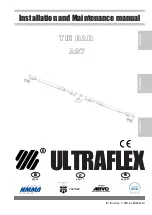
©
National Instruments Corporation
11
NI sbRIO-9601/9602/9602XT User Guide
Understanding Ground Connections
All of the grounds (D GND, ground lug P1, and the plated mounting holes)
are connected together internally on the NI sbRIO device. The ESD
protection diodes are connected to the plated mounting holes with a lower
inductive path than the path to D GND, so the best ESD protection is
provided by connecting the plated mounting holes and ground lug P1 to a
low inductive earth ground.
Care must be taken to
not
connect the grounds in such a way that stray
power supply currents traverse through the board. A good rule of thumb is
current flowing out of the connector should match current flowing in.
To verify correct grounding of the NI sbRIO device, make sure current
flowing into the power connector J3 equals the current flowing out of power
connector J3. These currents should be measured with a current probe after
final assembly of the end product and any current differences investigated
and removed.
All external power supplies should have their connected to a system ground
external to the NI sbRIO device. Do not use the NI sbRIO device as the
common system grounding point. Significant currents traversing through
the NI sbRIO grounds can result in digital component failures. If more than
3 A flows through the common (–) pin on the J3 power connector,
components start to fuse open.
Connecting the NI sbRIO Device to a Network
Use a standard Category 5 (CAT-5) or better Ethernet cable to connect the
RJ-45 Ethernet port to an Ethernet network.
Caution
To prevent data loss and to maintain the integrity of your Ethernet installation,
do
not
use a cable longer than 100 m.
If you need to build your own cable, refer to the
section for more
information about Ethernet cable wiring connections.
The host computer communicates with the device
over a standard Ethernet
connection. If the host computer is on a network, you must configure
the device
on the same subnet as the host computer. If neither the host
computer nor the device is connected to a network, you can connect the
two directly using a crossover cable.
If you want to use the device
on a subnet other than the one the host
computer is on, first connect the device on the same subnet as the host
computer. Use DHCP to assign an IP address or reassign a static IP address












































